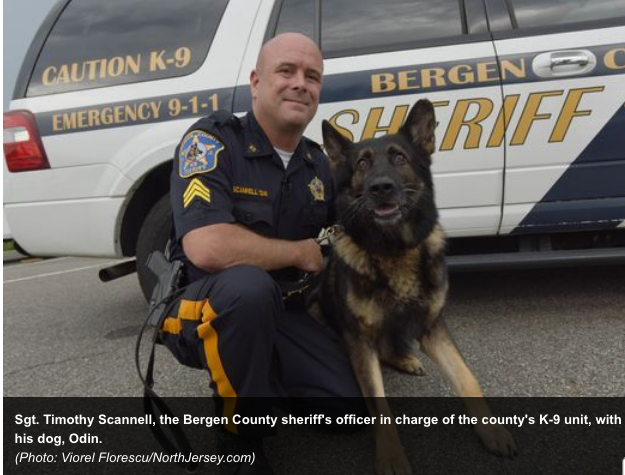Many local K-9 handlers have begun updating emergency plans and carrying
naloxone, the overdose reversal drug commonly known as Narcan,
specifically for their dogs.
August 9, 2017
WOODLAND PARK, N.J. — Every shift holds a different danger for Odin, a 6-year-old drug-sniffing German shepherd with the Bergen County Sheriff’s Office.
Sometimes the danger is passive — a bit of leftover rat poison or an alluring pool of antifreeze — and other times it’s nefarious, like when drug dealers booby-trap their lairs hoping to catch him off guard during police raids.
Now, the long-whiskered K-9 faces a new threat: fentanyl, the powerful synthetic opioid that dealers sprinkle into their heroin that sends highs higher and death counts soaring. Odin leads with his snout during narcotics searches, and if the K-9 absorbs the drug through his mouth or nose during his jittery waltz, it could kill him.
“Every time we take the dog out and do a drug search, there is a potential risk,” said Sgt. Timothy Scannell, Odin’s handler and the leader of the Bergen County Sheriff’s Office’s K-9 unit. “This makes it that much more dangerous.”
In response, many local K-9 handlers have begun updating emergency plans and carrying naloxone, the overdose reversal drug commonly known as Narcan, specifically for their dogs. With a drug like fentanyl, which the Drug Enforcement Administration said can be 100 times more powerful than morphine and 50 times stronger than heroin, no amount of worry seems excessive.
Avoiding danger
Dog handlers in the Bergen, Passaic and Morris sheriff’s offices said their dogs have avoided such run-ins largely because authorities thoroughly check crime scenes for potential hazards before fetching their four-legged partners.
Handlers are also uncannily in tune with their dogs, and sometimes able to head off disaster by sensing the slightest shift in the animal’s mood.
“They are your best friend, they are your partner,” said Scannell. “I spend more time with that dog than I do my two kids or my wife. That dog is always with me. So anything that’s the slightest bit off with him, you pick up in a heartbeat.”
It is unclear if there have been any K-9 overdose deaths nationwide. Yet stories have circulated about police dogs sickened by fentanyl, including a Florida K-9 that was given naloxone last October after showing signs of an overdose. The dog, a German shorthaired pointer named Primus, survived.
But handlers across the country got the message: The nation’s mushrooming opioid crisis, combined with the cheap fentanyl pouring in from China and Mexico, means incidents like this could become more frequent.
“It’s certainly more of an issue, because they’re seeing more fentanyl when they go into crime scenes,” said Diane P. Calello, executive director of the New Jersey Poison Information and Education System.
Absorbing the drug through the eyes, nose or mouth — as a dog might — ensures a more direct dose, she said.
Keeping K-9s healthy is paramount for officers and agencies — beyond the obvious emotional bond tethering handlers and their dogs, departments invest extraordinary amounts of time and money in each animal. The dogs are bought mostly from Eastern Europe for $7,000 to $10,000 and typically require at least six months of initial training and countless hours afterward, depending on their job, police said.
Taking precautions
Opioids affect canines and humans similarly, though dogs are slightly less susceptible, said Steven Hodes, a Mine Hill veterinarian who has cared for the Morris County Sheriff’s Office’s police dogs for 35 years.
Several factors, including size, age and the volume of drug ingested, determine how intensely the dog reacts, Hodes said. When dogs overdose, they show symptoms akin to those that would strike a human — loss of motor function, gradual loss of consciousness, unexpected collapse and possibly death.
“This drug is not to be taken lightly,” Hodes said of fentanyl. “I think for them to have access (to naloxone) almost immediately on site … is an awfully good idea for these police departments.”
This has led the Morris County Sheriff’s Office to give every K-9 handler an injectable form of Narcan to be kept both in their car and on their person, said Sgt. Aaron Tomasini, head of the office’s 14-dog K-9 unit.
“When we’re on the side of the road, there’s no real means to know whether we’re dealing with fentanyl,” Tomasini said. “So having the proper medication is our best measure to make sure that we, and the dogs, are safe.”
Tomasini, who has led the unit for two years, said Hodes trained officers to recognize the signs of an overdose as well as how to properly give the shots. Hodes said injectable Narcan is more reliable and works faster than the nasal spray.
Scannell, of the Bergen County Sheriff’s Office, said the 17 handlers in the county K-9 unit don’t carry Narcan because the drug is temperature-sensitive. But should any of the unit’s 22 dogs show signs of an overdose, handlers will call roving units that can bring Narcan quickly, he said.
Sgt. Jamie Tangorra, commander of the Passaic County Sheriff’s K-9 unit, said all of the unit’s 15 handlers worry about such a scenario — the dogs live with them, he said, and are part of their family.
As such, each handler was issued last year the nasal-spray version of Narcan and trained to use it, Tangorra said. If the handlers notice any odd behaviors in the dog — especially unresponsiveness — they will use Narcan immediately.
“We’ve taken every precaution we know of,” he said.
Follow Steve Janoski on Twitter: @SteveJanoski


